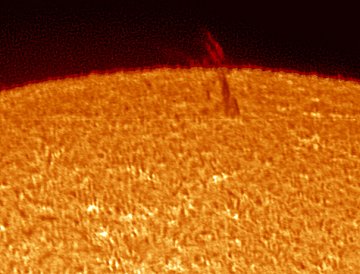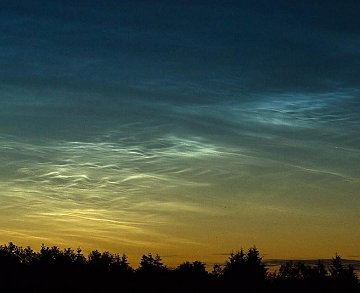 Where's Saturn? Is that a UFO--or the ISS? What's the name of that star? Get the answers from mySKY--a fun new astronomy helper from Meade. Where's Saturn? Is that a UFO--or the ISS? What's the name of that star? Get the answers from mySKY--a fun new astronomy helper from Meade. DISTANT SUN: Sweltering populations in the American west might find this hard to believe: Earth is extra-far from the sun today. On July 6th and 7th, Earth passes through a part of its orbit called aphelion, which is 5 million km farther from the sun than the opposite point in January. Unfortunately, this offers no relief from the heat. Click here to find out why. HOT CARPET: Why does the sun look like shag carpet? Consider this July 5th image from solar photographer Jack Newton: 
This is the view through his Coronado SolarMax90. In the forground we see hundreds of little orange "fibers" reminiscent of 1970s flooring. The shaggy threads are called spicules, Texas-sized jets of gas shooting up from the sun's surface. Because spicules rise and fall in only a few minutes, each snapshot looks a little different. Orange shag: another reason to watch the sun! Note: The big wild thread near the horizon is not a spicule but a prominence. Prominences are clouds of hydrogen held above the sun's surface by magnetic fields. They are larger than spicules, and much longer lasting. more images: from Rogerio Marcon of Campinas - SP - Brazil; from Monty Leventhal of Sydney, Australia; from John C McConnell of Northern Ireland. NOCTILUCENT CLOUDS: A glowing bank of noctilucent clouds (NLCs) rolled over Port Angeles, Washington, on July 3rd. "These are the first noctilicent clouds we've seen," says Rick Klawitter who took this picture: 
Photo details: Nikon D200, 30 second exposure at ISO 200, f8, 150mm.
"We noticed the clouds about 90 minutes after sunset--around 10:30 pm," he says. "By 11:15 pm they were gone." This display may signal the onset of regular sightings over the continental United States. NLCs are a summer phenomenon, and as summer progresses, the clouds descend from polar to middle latitudes. Now they've reached Washington, where will they go next? There's only one way to find out: Observers, check the western sky one to two hours after sunset. If you see silvery-blue tendrils spreading up from the horizon, you've probably spotted a noctilucent cloud. 2007 Noctilucent Cloud Gallery
["Noctilucent Cloud"--the song] [Night-Sky Cameras] | 
